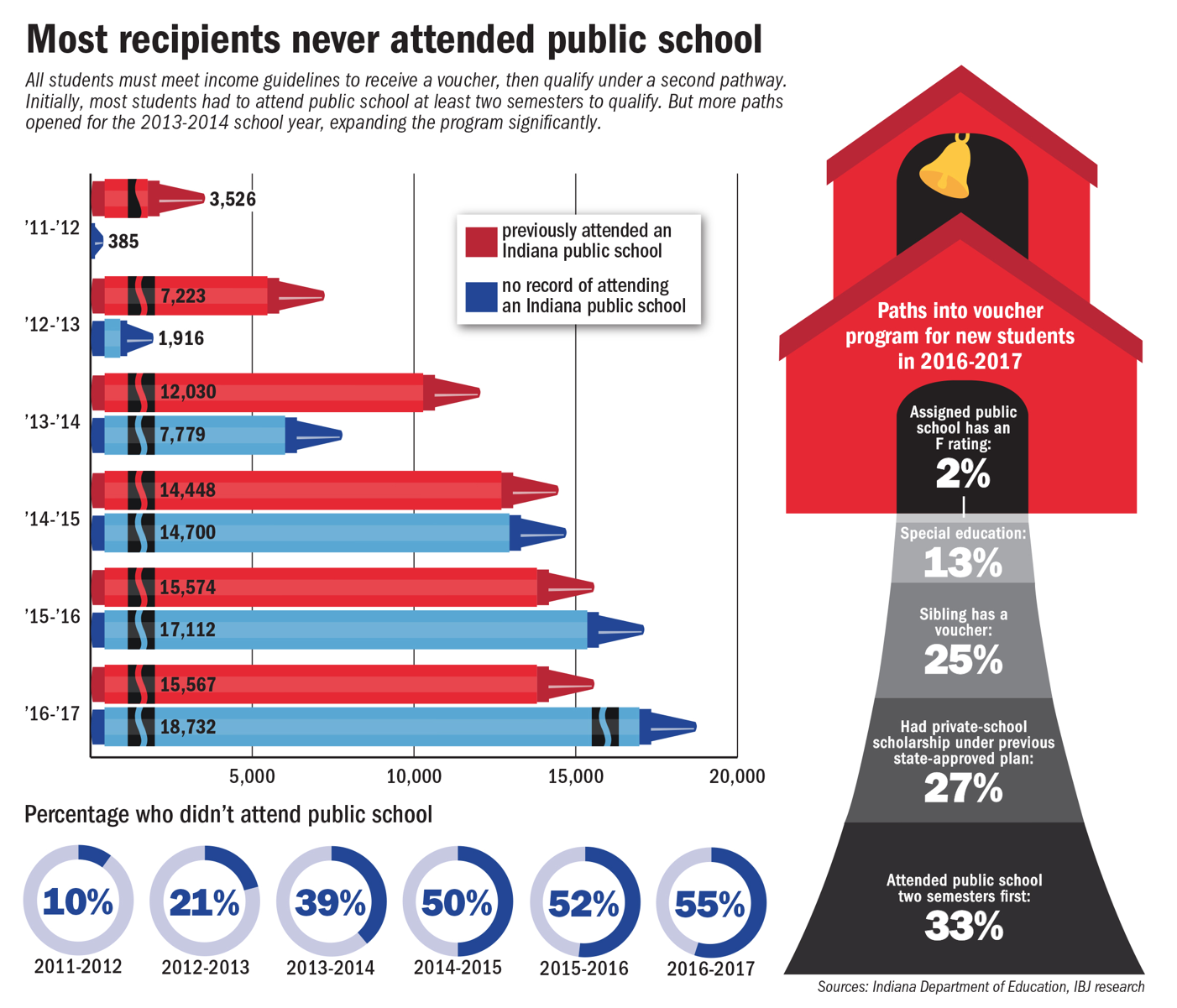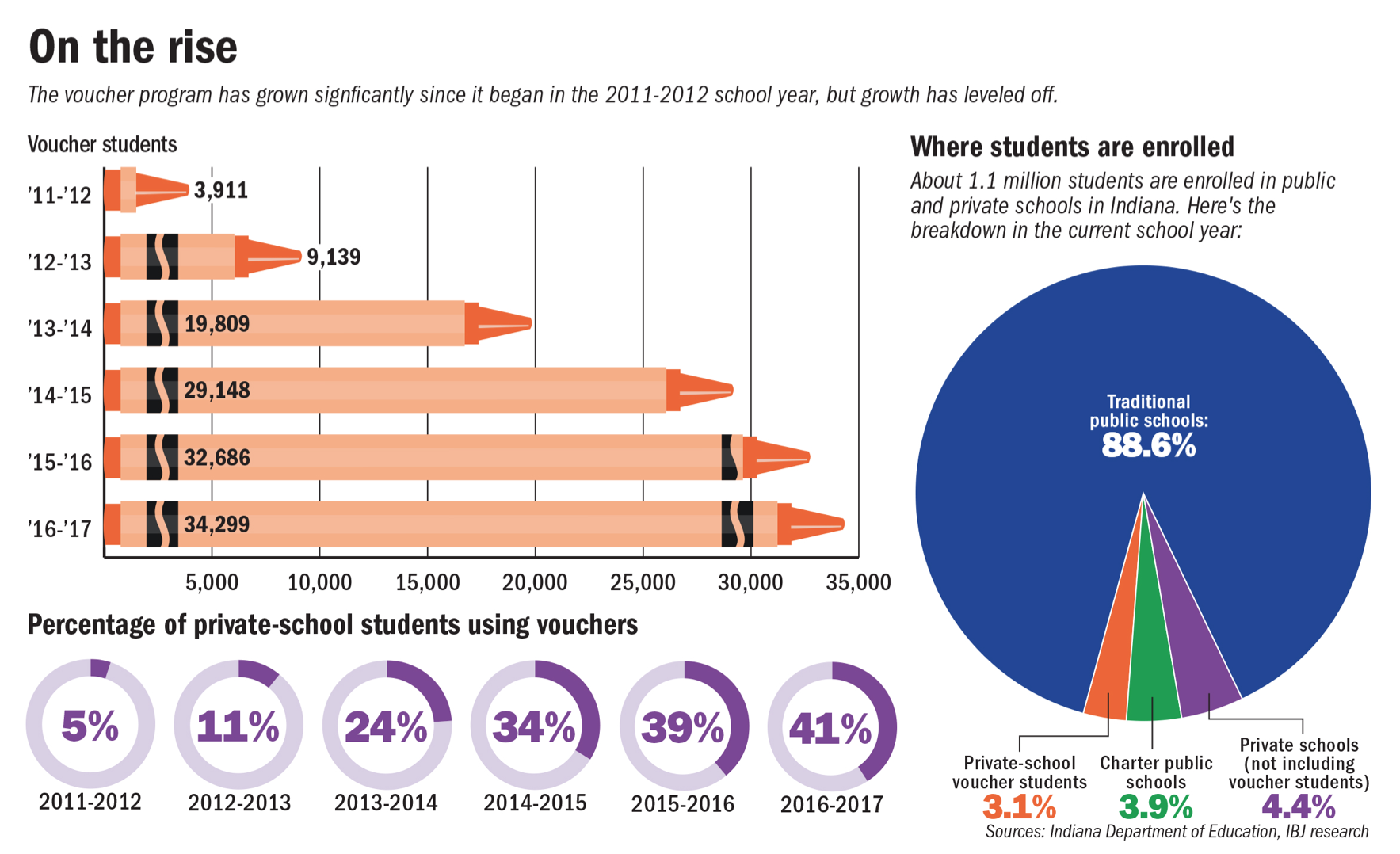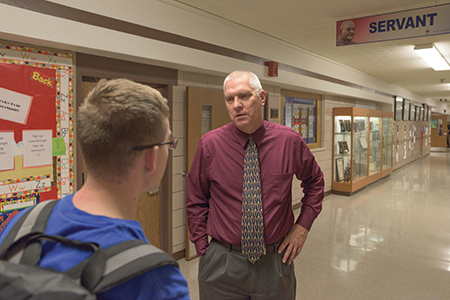Subscriber Benefit
As a subscriber you can listen to articles at work, in the car, or while you work out. Subscribe NowThe state has poured increasing amounts of taxpayer money into Roncalli High School on the city’s south side—a total of $5.2 million—since Indiana’s private-school voucher program launched in 2011.
But enrollment at the Catholic school hasn’t been rapidly rising.
That’s because the overwhelming majority of Roncalli students who use vouchers to subsidize their tuition would have gone to the school anyway, Principal Chuck Weisenbach said.
In its first years, the voucher program was designed to allow low-income students let down by public schools to attend private ones. But in 2013, that changed.
 Now, at Roncalli, the voucher money is in large part replacing the financial aid, loans or assistance students would have received from family members or the school, which has consistently been rated with an “A.”
Now, at Roncalli, the voucher money is in large part replacing the financial aid, loans or assistance students would have received from family members or the school, which has consistently been rated with an “A.”
But the students who are new tend to be Hispanic or Burmese, Weisenbach said, which has boosted the school’s diversity. He called vouchers “social justice.”
“That’s at the backbone at why the voucher program is needed, why we support it and why we think it has been embraced so enthusiastically,” he said.
But critics point to cases like Roncalli as evidence the voucher program—now in its sixth year and the broadest such program in the country—is foolishly spending tax dollars to subsidize private schools that were getting by on their own, hurting public schools in the process.
Fifty-five percent of the 34,299 voucher recipients this year never attended an Indiana public school, according to recently released state data.
“If you’re simply subsidizing people for what they would have done anyway,” said Purdue University economist Larry DeBoer, the program’s “bang for the buck” is in question.
This year alone, the state is expected to spend $146 million on tuition payments to private schools, about 2 percent of what it will spend on tuition aid for all schools. The voucher program serves about 3 percent of the state’s 1.1 million K-12 students.
Over six years, the state has spent more than a half billion dollars on vouchers. During that time, Indiana’s program has expanded, giving more students access to vouchers than in any other state—despite mixed evidence from researchers that vouchers help students achieve.
The impact of the program could reach far beyond Indiana’s borders. Former Gov. Mike Pence, a staunch voucher advocate, is now serving as vice president in an administration that has said it wants to implement vouchers nationwide. And U.S. Secretary of Education Betsy DeVos has praised other school-reform policies in Indiana.
But within Indiana, questions linger about student performance, DeBoer said. “There’s a question as to, ‘Where’s the money going?’” he said. “And there’s a question of if private schools should be more accountable.”
Even new State Schools superintendent Jennifer McCormick, a Republican who supports vouchers, said the public needs more answers about the state’s program, particularly as vouchers look poised to expand nationwide.
“I think it’s time to connect the dots, do our homework,” she said. “We’re in the spotlight because we owe it to the country to analyze the data.”
Here’s what we do know about the program, according to state data and an IBJ analysis:
• Research into vouchers’ impact on Indiana student achievement has been slim, but early results don’t look encouraging. National research, however, indicates black students might benefit more than others.
• Indiana’s voucher recipients have become whiter, more suburban and more affluent.
• Annual tuition support—the base funding for K-12 education—was up $558 million in 2016 over the year vouchers launched. The growth of the voucher program has eaten up one-fifth of that increase.
• The program has been good for private schools, with 41 percent of all private-school students now subsidized by vouchers.
• About 75 percent of voucher students last school year chose schools with A and B ratings.
Early studies
The voucher program started as a way to help improve education for children from low- and middle-income families who weren’t succeeding in public schools.
In most cases, first-time voucher recipients are eligible if their family’s income is at or below 150 percent of the amount that qualifies for the federal reduced-price lunch program. In 2017, students from families of four earning up to $67,433 qualify.
Families with income at or below 100 percent of reduced-price lunch guidelines receive a higher voucher.
The program launched under former Indiana Gov. Mitch Daniels and he branded it a win for social justice. But six years later, it’s unclear whether that goal has been reached.
A 2015 review of the national research on ongoing voucher programs from the National Bureau of Economic Research found “the evidence does not suggest that awarding students a voucher is a systematically reliable way to improve their educational outcomes.”
The analysis “points to non-existing or not very robust effects of vouchers on test scores, except perhaps for black students.” But it did find some evidence that vouchers have positive effects on high school graduation rates, especially for black students.
A study on academic achievement in Indiana’s voucher program is under review at an academic journal, according to one of its researchers, Joe Waddington of the University of Kentucky and formerly of the University of Notre Dame. Waddington said he could not participate in an interview in advance of the study’s final release. Notre Dame has a data-sharing agreement with the Indiana Department of Education.
But a 2016 Notre Dame study published in the Education Finance and Policy journal—also conducted by Waddington and fellow researcher Mark Berends—assessed the academic effects of school choice in Indianapolis.
That study—which used five years of demographic and test-score records to measure achievement for students in grades 3-8 across school types—found that students switching to Catholic or other private schools “scored at approximately the same level as their peers remaining in traditional public schools and slightly below the overall Indiana mean.”
“However, students switching to private schools achieved at substantially lower levels than peers in their new Catholic or other private school,” the study found.
Indianapolis students switching to Catholic schools experience “moderate and statistically significant average annual losses in mathematics … compared with the gains they experienced while attending traditional public schools,” according to the study, and the researchers “estimate zero annual gains” for Catholic-school switchers in English and language arts.
The study found no statistically significant difference in achievement gains between students who switch to Catholic schools using a voucher and those without a voucher.
Different measures
John Elcesser, a voucher advocate and executive director of the Indiana Non-Public Education Association, said private schools need to “continue to work on better helping kids make the transition” into private schools. But he said he is “pretty confident” voucher recipients will perform better in studies over time.
“I think as time passes and as Notre Dame continues to study longitudinally, we’re going to see what we’ve always assumed: The longer kids have the opportunity and they get adjusted to the expectations, we’re going to see they’re going to be successful over time.”
Regardless, some advocates say students don’t need to perform better to make vouchers a success. They say the program should be about giving parents the ability to choose a child’s school based on their values.
“If test scores didn’t change one bit, but a parent had [his or her child] in a situation that met their needs—in our case, a Christian education—the program is well worth it,” said Jeff Freeman, CEO at Heritage Christian School on Indianapolis northeast side.
Glenn Tebbe, executive director of the Indiana Catholic Conference, said “parents would make different choices” if they weren’t satisfied with the program.
“While it’s important for students to be able to achieve—everybody wants that—that only is an outcome that would come from parents making the right choice for the best fit for their child,” Tebbe said.
But McCormick said judging the program by its academic results for disadvantaged students is vital.
“When this program was rolled out—and I still hear this from folks at the Statehouse and those who are really supportive of the program—the intent was to make sure students had the opportunity to get out of really low-performing schools,” the superintendent said. “I think it does result in us needing to take a pause and go back to the initial intent of the program.”
She said the Education Department is evaluating ongoing research—and has considered contracting to conduct a study of any key areas not currently under scrutiny.
“We need to be transparent,” McCormick said. “We’re trying to provide accurate information for folks who are asking about a lot of money being spent on this program. Let the data tell the story.”
Former State Schools Superintendent Glenda Ritz, a Democrat and opponent of vouchers, was more pointed.
She criticized lawmakers for their quick expansion of the program before knowing how it would affect student learning.
“We’ve spent hundreds of millions on this school voucher program and the only data we have to show is that it isn’t helping students academically,” Ritz said.
Whiter, more suburban
As Indiana’s voucher program has sprinted along, critics—and people who are friendly to school choice—are concerned about data from the Indiana Department of Education that shows the program has morphed to include a majority of children who have never attended public school.
Starting in the fourth year of the program, in 2014-2015, about half the recipients had no record of ever attending a public school. That proportion has ticked up since, to 55 percent.
Even strong supporters of the program have reservations about that shift.
Senate Appropriations Chairman Luke Kenley, R-Noblesville, said he “lost the battle” in 2013 over maintaining one of the program’s original requirements: Would-be recipients had to attend a public school for two semesters before becoming eligible for a voucher.
“I felt it should be for people who had tried [public school] but weren’t satisfied,” Kenley said. “As time goes by, perhaps we will accumulate enough information that the Legislature needs to review that decision.”
In 2013, the Legislature expanded pathways into the voucher program to let students bypass public school if they are designated special education students, are assigned to schools that had received a state grade of F, or have siblings using vouchers.
But few new voucher students—just 2 percent—cite escaping a failing school as their pathway into the program this year.
 As the program has expanded, its makeup has changed.
As the program has expanded, its makeup has changed.
The percentage of black voucher recipients has decreased about 12 percentage points in six years, to 12.4 percent. Hispanic voucher enrollment has held steady at about 20 percent. The percentage of white voucher students has risen about 14 percentage points, to 60 percent.
Geography has changed, too. The number of voucher recipients living in urban areas has dropped about 8 percentage points, to61 percent. Suburban enrollment has increased 7 percentage points, to 23 percent, while the percentage of recipients living in rural areas and towns has stayed steady.
Participation from families with higher incomes is also on the rise.
Higher voucher awards are reserved for students whose families earn 100 percent or less of the reduced-price lunches guidelines. Those vouchers averaged about $5,700 last school year but can fluctuate based on state funding, voucher enrollment and the school the student chooses.
Students whose families earn150 percent of the reduced-lunch guideline receive a lesser voucher, which averaged about $3,000 last year.
In 2011, about 85 percent of recipients qualified for the higher award. This year, that figure was 68 percent.
And because of another 2013 expansion of the program, students can keep their vouchers after the first year if their family income increases to up to 200 percent of the reduced-lunch guideline. A family of four under that requirement could make up to $89,910.
Hardy Murphy, executive director of the Indiana Urban Schools Association, said he is worried about whether “students are exercising options that are resulting in isolation by race and socio-economic status.”
“Who are these families and parents that left [public schools] and who are the students that stayed?” he said. “It could be you have a student population that even more desperately needs funds that have been diverted away from the urban school.”
But Tebbe—from the Catholic Conference—said focusing on the decreased minority population of the voucher program is “probably looking at the glass half empty,” as white students using vouchers are still slightly disproportionally underrepresented compared with the size of the white student population statewide.
“The fact that more low-income families that are taking advantage of this may also be Caucasian is not necessarily in and of itself a bad thing,” Tebbe said. “It’s designed to give low- and middle-income families advantages that more affluent families have always had.”
Several private-school leaders told IBJ the increased socioeconomic and ethnic diversity at their schools has been a key benefit of vouchers.
“We’re thrilled, because we see families who otherwise might not have the opportunity to be at Heritage,” Freeman said. “We think that expands our reach as a school strategically.”
Saving money?
Determining whether vouchers have been a wise state investment requires an analysis of their cost and the program’s impact on traditional public schools.
But even that has been controversial.
The state expects to spend $146 million on voucher awards this year—up from $132 million last year. And the two-year budget being hashed out at the Legislature includes an expected jump to $163 million by 2019.
 Funding for vouchers is becoming a larger part of state spending on tuition support, from just a fraction of 1 percent in its first year to about 2 percent now. And growth of vouchers spending is also outpacing the growth in base education funding.
Funding for vouchers is becoming a larger part of state spending on tuition support, from just a fraction of 1 percent in its first year to about 2 percent now. And growth of vouchers spending is also outpacing the growth in base education funding.
Annual tuition support statewide grew $557.5 million from 2011 to 2016, while annual voucher costs grew $116 million—accounting for about 20 percent of the increase. That’s largely because the number of students enrolling in vouchers is growing faster than the number of students enrolling in public schools.
Still, voucher advocates make the case that vouchers are cost-savers—because the state spends less on one voucher than it spends to send one student to public school. In this year’s voucher report, the state said that, if all the students going to private school in part on the state’s dime had attended public schools, the cost would have been $214 million.
But Molly Stewart, a researcher at IUPUI’s Center for Evaluation and Education Policy, said that presumes voucher recipients would be in public school without the vouchers—and that’s not the case in Indiana.
“Because of these expanded pathways, there’s no way you could say the program is saving the state money,” Stewart said. “That is inaccurate.”
In the first years of the program, lawmakers required the Department of Education to calculate expected savings from vouchers. In the first year, it said the program was saving the state $4.2 million in funding, which was redistributed to public schools. But after just two years, that number turned negative. In 2015-2016, that “savings” figure stood at a negative $53 million.
Lawmakers stopped requiring the calculation, and McCormick’s administration did not include it in its report this year.
But Jeff Spalding, a former fiscal and policy analyst for education-reform group Ed Choice, said the question is not whether the program saves money, but “whether it creates a more desirable educational environment in the state.”
‘Definitely a hit’
Critics say that can’t be determined without evaluating the hit on public schools.
Some voucher advocates say vouchers help public schools by reducing the number of students they need to teach. But Spalding said that oversimplifies the problems that declining enrollments cause for a person managing a public-school budget.
“If you’re a CFO of an enterprise losing customers and losing revenue, that’s always a problem,” Spalding said.
And indeed, public schools—particularly districts with the highest numbers of students using vouchers—say they have been hurt.
“It’s definitely a hit for us financially,” said Kathy Friend, CEO of Fort Wayne Community Schools. “When the revenue leaves the school, it doesn’t mean the expenses leave the school.
“When we lose students, we don’t lose them conveniently from one grade at one school,” she said. “If I go from a class size of 25 to 23, I still have to pay for that teacher, but I’m losing $12,000 because those students aren’t there anymore.”
Fort Wayne’s enrollment has dropped by about 1,000 students—or 5 percent—since the voucher program started, and the district has closed an elementary school.
According to the state, 4,680 students who are using vouchers (worth $19.8 million) live in the Fort Wayne district’s boundaries.
But not all public districts affected by vouchers are shrinking. Lawrence Township in Marion County actually has grown—the district had 14,878 students in 2011-2012 and 15,936 students in 2016-2017. Superintendent Shawn Smith said continued marketing is important because, “We certainly don’t want to put our shield down.”
“Vouchers have certainly awakened the public schools because it’s competition,” Smith said.
But the competition doesn’t necessarily lift all boats—especially in rural areas with limited access to private schools.
 Murphy
Murphy“They’re not getting what they used to get and some of that money is now [going to] school options that they don’t have,” Ritz said.
More than $3 million in voucher money is spent on students who live within the boundaries of the nearly 70 schools represented by the Indiana Small and Rural Schools.
Scott Turney, the group’s executive director, acknowledges his districts haven’t been hit by vouchers as hard as districts in more populous areas. But he said vouchers still affect small and rural schools, which he contends already feel cash-strapped.
“We believe it’s taken away funds from the money the state would be spending on public schools,” Turney said. “It all comes out of that same pie for education. Schools have been cutting and cutting, but the funding is still not catching up, even with all the many cuts.”
A boon for privates?
Comparatively, the program appears to be a financial boon for private schools as the state is funding increasingly more of their students.
In the first year of the program, 5 percent of all private-school students used vouchers. This year, that figure is 41 percent. Statewide private-school enrollment, meanwhile, has risen just 16 percent.
Vouchers have certainly helped Roncalli. Weisenbach, the school principal, said the school’s $5.2 million in state reimbursement over six years has allowed Roncalli to “set aside a seven-figure number” in savings. And vouchers have “certainly allowed us to move more aggressively” in increasing teachers’ salaries.
But he said the money can’t be characterized as a windfall because even the largest vouchers don’t cover the school’s annual $9,000 tuition, making financial aid still necessary. He said vouchers are “underfunded.”
Usage of vouchers has continued to increase but is slowing from its once-explosive growth, likely due to shrinking private-school capacity statewide, experts said.
Still, some Indiana Republicans want to go even further—proposing so-called education savings accounts where all parents could have direct access to education money they can use anywhere. But Sen. Kenley, one of the architects of the state budget, worries how that would affect public schools.
“I’m not an enthusiast for a universal voucher,” he said. “We’re always going to have public schools to meet our constitutional requirement, so therefore it’s incumbent to keep the public schools as good an offering as we can.
“If you have too many options to get out of the system, you begin to distort the value,” he said. “Going to a good public school is a beneficial experience in developing good citizens. When you start segregating people, you start to get some unintended negative consequences.
Please enable JavaScript to view this content.


